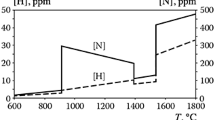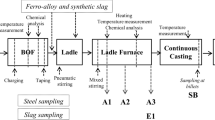Conclusion
For steels obtained by electroslag remelting, which are characterized by low sulfur content, it was discovered that their mechanical properties can be changed by controlling the shape and distribution of inclusions of the nonmetallic phase, viz., manganese sulfides, during heat treatment. Increased purity of steel and the attendant reduction of the size of sulfides has the result that they can dissolve during relatively low heating which is often used in production for carrying out plastic deformation.
It should be noted that when the cooling regimes are varied, there occur changes of morphology and of the distribution of inclusions almost in the entire temperatrue range of the existence of stable austenite. The values of impact toughness are directly dependent on the nature of the segregation of sulfides in heat treatment, regardless of renewed heating which is accompanied by recrystallization of the steel. Consequently, with steels obtained by electroslag remelting it is important to control not only the regimes of final treatment but also the temperature of the initial heating, the cooling rate, and also a possible delay of cooling in the austenitic range at the preliminary stage of heat treatment.
Similar content being viewed by others
Literature cited
E. T. Turkdogan, S. Ignatowicz, and J. Perrson, "The solubility of sulphur in iron and iron-manganese alloys," JISI,180, No. 4, 349–354 (1955).
K. A. Malyshev, "Aftereffects of the overheating of steel," in: Transactions of the Institute of Metal Physics, Ural Branch, Academy of Sciences of the USSR, Sverdlovsk (1946), pp. 3–10.
K. A. Malyshev, "Stonelike fracture of steel in connection with its overheating in hot mechanical treatment," Stal', No. 11–12, 354–356 (1944).
V. D. Sadovskii and K. A. Malyshev, "Fractures of structural steel," in: Transactions of the Institute of Metal Physics, Ural Branch, Academy of Sciences of the USSR, Issue 17, Moscow (1956), pp. 111–118.
V. D. Sadovskii, K. A. Malyshev, A. M. Polyakova, et al., "Stonelike fracture in structural alloy steels," Stal', No. 6, 545–548 (1955).
Yu. V. Latash and K. A. Medovar, Electroslag Remelting [in Russian], Metallurgiya, Moscow (1970).
A. P. Gulyaev, Pure Steel [in Russian], Metallurgiya, Moscow (1975).
I. S. Kaptyug and A. Ya. Golubev, Fibrous Fracture and Lamination in Steel [in Russian], Metallurgiya, Moscow (1982).
G. Joy and J. Nutting, "Influence of intermetallic phases and nonmetallic inclusions upon the ductility and fracture behavior of some alloy steels," in: Effect of Second-Phase Particles on the Mechanical Properties of Steel, The Iron and Steel Institute, London (1971), pp. 951–1000.
N. M. Gerbikh, A. B. Kut'in, A. M. Polyakova, and L. V. Smirnov, "Influence of the cooling rate in the austenitic range on the nature of failure of steel," Fiz. Met. Metalloved.,61, No. 5, 1029–1031 (1986).
S. Preston, G. Hale, and J. Nutting, "Overheating behavior of grain-refined low-sulphur steel," Mater. Sci. Technol.,1, No. 3, 192–197 (1985).
Additional information
Institute of Metal Physics, Ural Scientific Center. Academy of Sciences of the USSR. Translated from Metallovedenie i Termicheskaya Obrabotka Metallov, No. 11, pp. 15–19, November, 1987.
Rights and permissions
About this article
Cite this article
Sadovskii, V.D., Kut'in, A.B. & Gerbikh, N.M. Effect of the sulfide phase on the properties of steel after heat treatment. Met Sci Heat Treat 29, 817–822 (1987). https://doi.org/10.1007/BF00707748
Issue Date:
DOI: https://doi.org/10.1007/BF00707748




